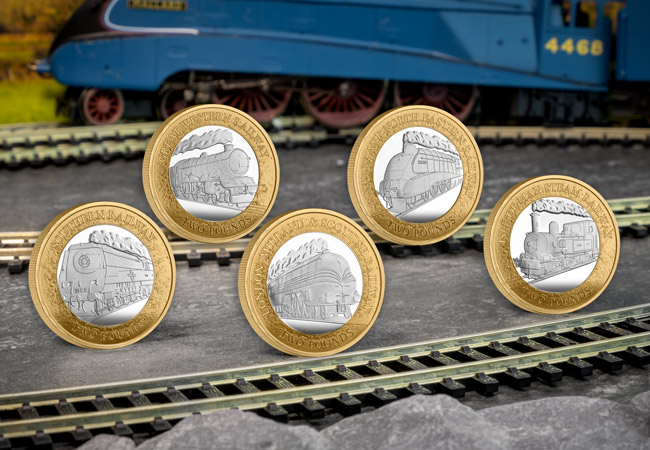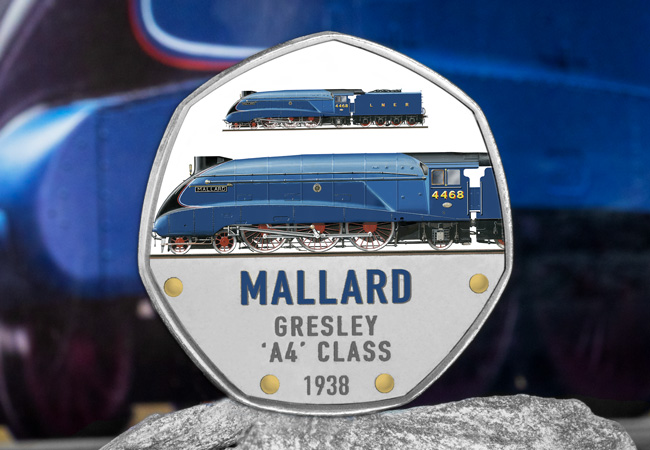Shop
2023 UK Darth Vader™ and Emperor Palpatine™ 50p coin design
Take a look at what makes the Dark Side so appealing…
So much thought and effort go into making coins the miniature works of art they are and designers will often include details for eagle-eyed collectors or knowing fans.
That’s true of the brand-new UK Darth Vader 50p. The coin, which features Darth Vader and Emperor Palpatine, carries an authentic depiction of the two iconic villains, but the designer goes beyond that.
Click on the points below to learn more about the coin’s design and the Star Wars universe that inspired it.
Which specification are you choosing?
The UK Darth Vader and Emperor Palpatine 50p coin is available in a range of different specifications. Click on the points below to find out more about each one.
The Need for Speed: 5 Facts About The Mallard
When it comes to pushing the boundaries of engineering and speed, one name stands out above the rest in the annals of railway history – the Mallard.
This iconic steam locomotive holds a special place in the hearts of enthusiasts and historians alike. Join us as we delve into the story of the Mallard and uncover five fascinating facts about this legendary machine.

Credit: G-13114 at English Wikipedia, CC BY-SA 4.0
The Record Breaker
The year was 1938, and the quest for speed was on.
The Mallard took centre stage when on July 3rd of that year, it embarked on a mission to break the world speed record for steam locomotives.
Rocketing along the East Coast Main Line, near Grantham, the Mallard reached an incredible speed of 126mph, breaking the record previously held by Germany’s DRG’s Class 5 Locomotive that had reached 124.5mph in 1936.
And the Mallard’s world record still stands to this day.
A plaque has been mounted on its side to commemorate its historic achievement, proudly displaying its maximum speed of 126mph.

Credit: Alan Wilson at English Wikipedia, CC BY-SA 2.0
Designed for Speed
The brainchild of Sir Nigel Gresley, the renowned chief mechanical engineer of the London and North Eastern Railway (LNER), the Mallard was built at the Doncaster Works.
Gresley incorporated several features to maximize speed, including a streamlined body and a three-cylinder design for greater power and efficiency.
A Train of Firsts
The Mallard was not only a speed demon but also a pioneer of innovative technologies.
It was the first locomotive to be fitted with a Kylchap double blastpipe and chimney, which significantly improved steam flow and enhanced performance.
Additionally, it was one of the first locomotives to be painted in the iconic LNER garter blue livery, making it instantly recognizable.
A Legacy Preserved
Today, the Mallard is part of the National Collection, residing in the National Railway Museum in York. Following a restoration project which brought the Mallard back to its former glory, the magnificent locomotive is a star attraction.

Credit: G-Man at English Wikipedia, CC BY-SA 3.0
Links to Ornithology
Gresley had a keen interest in birds and birdwatching and as such many of the locomotives in the A4 class were named after birds.
Including the Mallard, Falcon, Golden Eagle, Sparrow Hawk, Kingfisher, Wild Swan and Guillemot to name a few…
Yours FREE: The Mallard Commemorative
Today you can own the first issue in the British Railway Heritage Collection – The Mallard Commemorative – for FREE. You’ll only pay postage.
The Mallard Commemorative is the first in a collection celebrating Britain’s Railway Heritage – with each issue featuring an intricately illustrated locomotive from the annals of railway history.
By ordering your commemorative today, you have the chance to trial the British Railway Collection for FREE (+postage) with absolutely no obligation to continue collecting if you don’t want to.
Introductory Offer
The Mallard Commemorative is an Introductory Offer for the British Railway Heritage Collection. Each month, you’ll receive four commemoratives for £25.00 (+p&p). You’ll also receive your FREE Presentation Album to house your collection. You can cancel your subscription at anytime.
Crafting History in Art: Exclusive Interview with Steve Wyse – The Creative Mind Behind The History of British Railways £2 Sets
Prepare to be transported into the world of artistic ingenuity as we present a captivating interview with Steve Wyse, an esteemed Honorary Member of the Guild of Railway Artists. Join us in exploring the creative process, inspiration, and meticulous attention to detail that culminated in the exquisite designs gracing the freshly minted History of British Railways £2 Sets, creating a bridge between history and numismatic art.
Tracing Tracks: Unveiling the History of British Railways BU and Silver £2 Coin Sets
In the annals of British history, the year 1923 marks a pivotal moment that reshaped the nation’s railway landscape forever. A convergence of 120 regional railway companies gave rise to four prominent entities, as a result of the Railway Act of 1921.
Now, in a splendid tribute to this transformative event, special Brilliant Uncirculated and Silver Proof £2 Coin sets have been issued.
This extraordinary coin collection stands as a tribute to an era when steam and steel connected cities, fuelled the Industrial Revolution, and united the kingdom.
Click the circles below to find out more about the design and the sets:
Each gleaming £2 coin encapsulates the essence of a bygone era, immortalising five of the most iconic locomotives that once traversed the British countryside. Encased in special presentation packs, these coins are elevated by the artistic brilliance of Steve Wyse, an Honorary Member of the Guild of Railway Artists. Through his skillful renderings, the spirit of each locomotive comes alive, inviting you to relive the golden age of rail travel.
But for those who seek the pinnacle of numismatic excellence, we invite you to take a step further. Behold the History of British Railways Silver Proof £2 Coin Set—a masterpiece that merges history, artistry, and exclusivity.

Limited to just 295 sets worldwide and meticulously struck from Sterling Silver, each coin has been crafted with precision and minted to perfection. These sterling silver coins are a stunning homage to the railway heritage.
Each coin is a portal to the past, an ode to innovation, and a salute to the journeys that shaped a nation. Choose your piece of history and become a guardian of the tracks that connect the past to the present.

